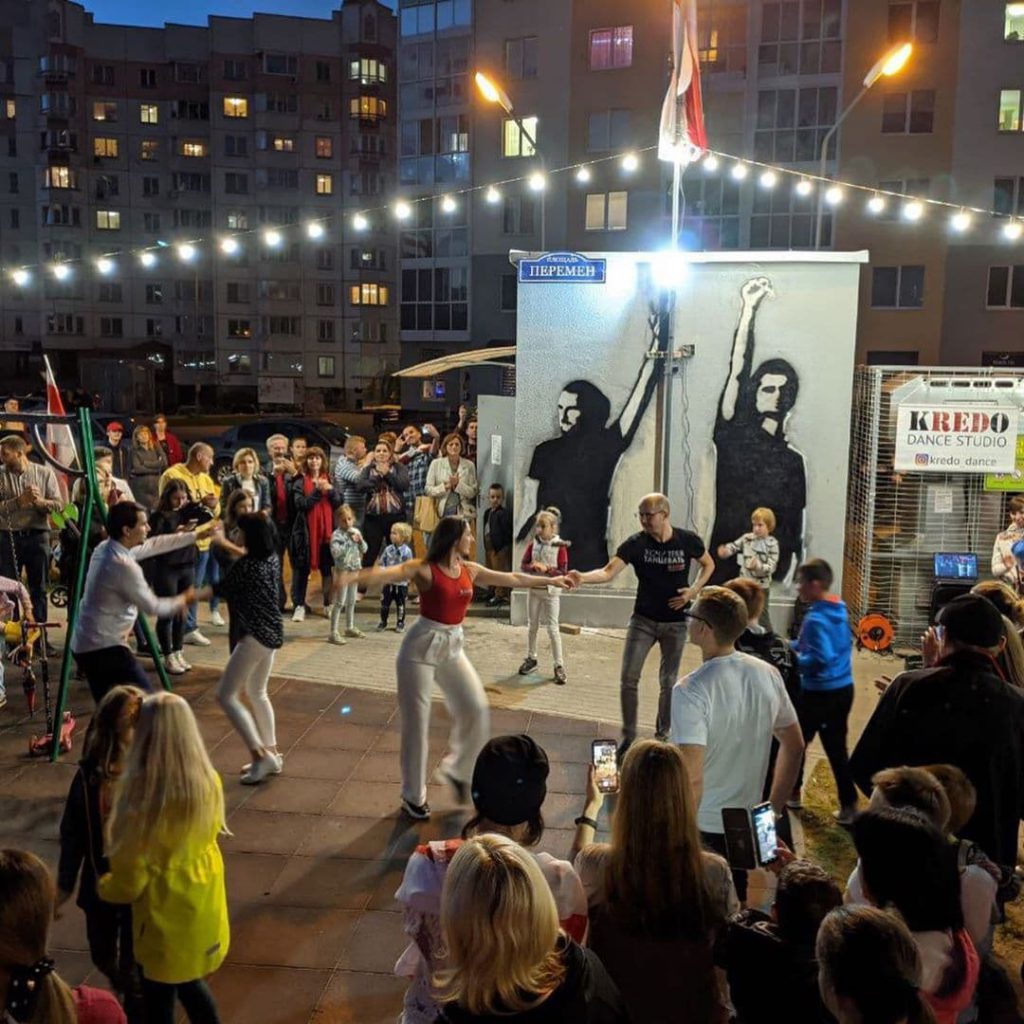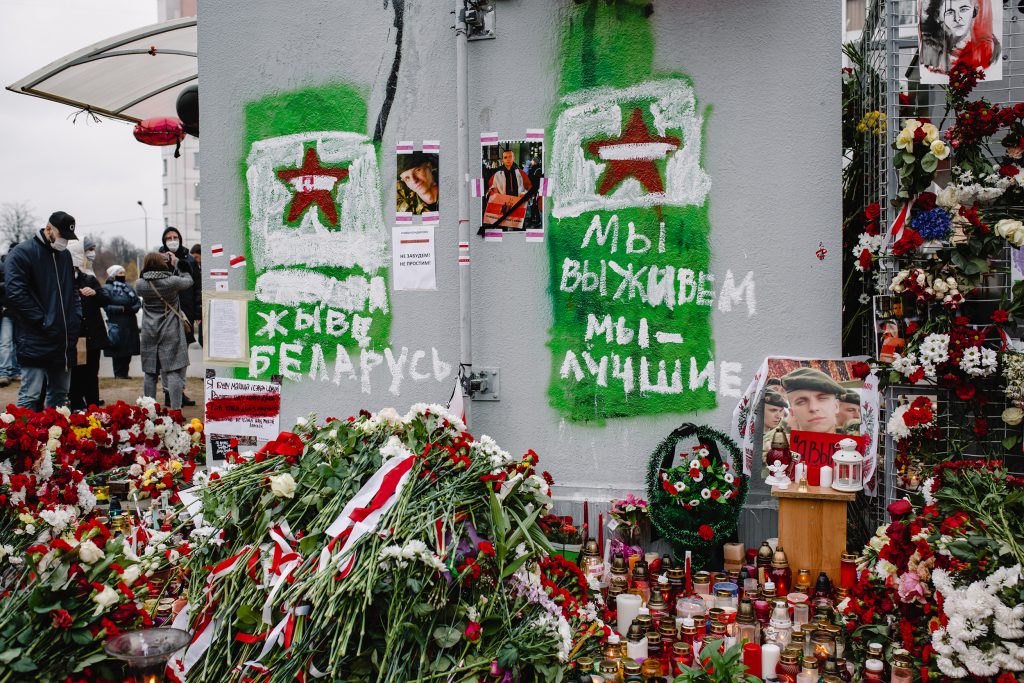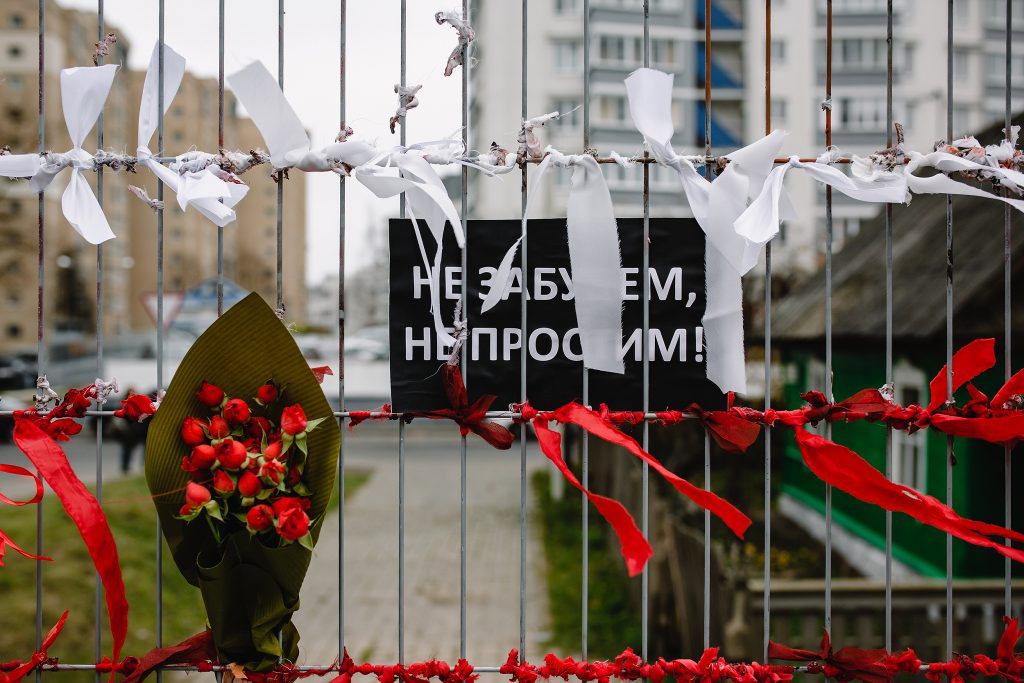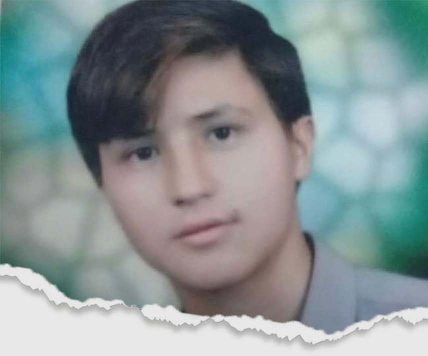
The protests, which began in Belarus immediately after the announcement of the presidential elections’ results, have not stopped for several months. One of the main symbols of the ongoing unrest in Minsk is the “Square of Changes.” This small courtyard in the Belarusian capital not only became famous throughout Minsk and far beyond its borders but has also gone down in history.
“In those days, people needed hope like a breath of air”
“Mom, the minibus has arrived there again!”, a girl of about seven years old pulls the woman’s hand excitedly, pointing towards the road. There was indeed a minibus parked there with tinted windows. Even children in this courtyard know that people in balaclavas are sitting inside it, and they can grab civilians at any moment. We met with the mother of the little girl and other local courtyard residents at the very “Square of Changes,” the existence of which probably everyone knows in Minsk and throughout Belarus. The name of this courtyard is even on Yandex.Maps today.
By itself, the “Square of Changes” is not a square at all but a small playground on Minsk’s Charviakova street with a booth from the ventilation room of the underground parking in the middle. It is the very first “protest yard” in the Belarusian capital.
Next to the courtyard is Kijeuski Garden Square, where, on August 6, 2020, during a pro-government holiday organized by the city administration, two DJs from the local Palace of Children and Youth played Tsoi’s song “Changes” and raised their hands with white bracelets – a symbol of Lukashenka’s opponents.
The DJs, Kiryl Halanau and Uladzislau Sakalouski, were arrested almost immediately and sent to the isolation ward. A few days later, a mural with their image appeared on a booth between Charviakova Street and Smorhauski Trakt in Minsk. And next to it, on the signboard, which spells out the rules for using the playground, a new item appeared: “law enforcement officers are prohibited on the site.”

“The mural was first painted on August 12,” local residents recall. “Just after the first terrible post-election nights, when the security forces brutally beat people on the streets of their city. On that day, for the first time, girls in white clothes lined up in a chain of solidarity near the Kamarouski market. There was no justification for сruelty and injustice, and such a symbol as “DJs of Changes” simply had to appear. People needed hope in those days like a breath of air. It was terrifying, but it warms up and gives strength to live and act further when there are many of you.”
Some friends are the authors of the mural on the “Square of Changes” on Charviakova Street. They are also local residents. When they were asked why they had portrayed the DJs, and not, for example, Sviatlana Tsikhanouskaya, they answered:
– Sviatlana is undoubtedly a hero, but the DJ guys are the most common people who were not afraid to stand against the system in which they also had to work. It was an act coming straight from their hearts – no one paid for it, no one planned anything, that’s why it is perceived so strongly. The value of their deed is in pure faith, hope, courage, and sincerity.
the magazine
By clicking „Sign up”, I give permission to receive newsletter Unblock sent by Outriders Sp. not-for-profit Sp. z o.o. and accept rules.
“A real hunt has begun on the inhabitants of the “Square of Changes”
The fame of the courtyard spread immediately. And as soon as people wearing balaclavas came to paint over the mural, it increased significantly. People wearing masks poured bitumen on the “DJs of Changes” ten times, and ten times the local residents resurrected the mural. Every day, thousands of Minsk residents came to see it, and the courtyard itself was called the “Square of Changes” in honour of the “DJs of Changes.”
The courtyard’s popularity grew so much that soon a police patrol began spending nights there guarding the painted booth. But as soon as the security officials left, the image of the DJs appeared on the wall again.
Over time, apart from the AMAP officers wearing masks, “tsikhary” in civilian clothes began to inhabit the yard. A real hunt for the most active local residents began in the courtyard. It all started with fines. So, for example, for the allegedly uncoordinated mural image, the partnership of owners of three houses adjacent to the “Square of Changes” was fined by the city administration for a pretty huge amount of money, which local residents now pay together.
And then the pressure began on the residents. On September 8, two local residents were detained when they went out into the yard to take out the trash. After some time, they were released. A few days later, the security forces clung to a child who wrote “Long Live Belarus!” on the asphalt with crayons. The child’s mother was asked to have a conversation with the child about prohibited symbols. And already on September 15, unknown persons in masks arrested a local resident Stsiapan Latypau, who blocked the road to the mural for the security officials when they came to destroy it once again.
After the arrest, the man’s apartment was broken into; after a search, he was accused of trying to use poisonous substances against the security forces because they found a bleach and a drug for baiting insects and rodents at home! Stsiapan Latypau then ended up in an isolation ward on Akrestsina Street, and later, he was charged with a serious criminal article related to the organization of mass riots.
For some time after Stsiapan’s arrest, the painted-over art object was not restored, but, later, Stsiapan Latypau’s image appeared on the wall, and the residents of the courtyard were united as never before.
“All these are the actions of people who do not need to be told how to live”
“Without the residents of these houses, their activity and desire to live in a free country, the further history of the “Square of Changes” would not have happened,” says the local Uladzimir. “We became friends, and soon our courtyard became a symbol of a new era of good neighbourliness.”

Right in the courtyard, the residents began to organize dance master classes, fairs, courtyard celebrations and show cartoons, concerts. The “square” even got its Telegram channel called Radio of Changes, in which the locals posted posters and important news from the courtyard.
Even actors of the Kupalauski Theater began to come to perform in the courtyard, and they soon became one of the symbols of the Belarusian protest. After the theatre director, Pavel Latushka, was fired for opposition views, almost the entire acting troupe of the theatre followed him with resignation statements.
“When you see how several hundred people gather in their courtyard in the evening to discuss everyday problems and just have some tea, and then they arrange an impromptu mini-concert with songs accompanied by a guitar, it moves you to tears,” the resident Mikhail Seviarynau says. “Although, if you think about it, these are, in general, the simplest things – mutual assistance, good neighbourliness, respect to people. Remember, even in our childhood; all the children came from a common yard sandbox. Today we dined in one apartment, tomorrow we would dine in another. How did it happen that, in less than thirty years, everything has changed so much? People no longer know who lives in the neighbourhood.”
“For me, such activity of our yard residents is also a way of the free expression of the will of citizens. To tie thousands of new white-red-white ribbons on the fence (“tsikhary” also cut them off at night), restore the mural, hang a new flag, organize a concert on the balcony, arrange dances, sing songs, smile at each other, treat a neighbour with tea – all these are actions of people who do not need to be told how to live and do the right thing.”
The longer I communicate with the locals, the more their neighbours come up to us and join the conversation, wishing to express their opinion on the history of the most friendly courtyard in Belarus.
“I am fighting for my rights to make decisions in my native country,” Mikhail enters into a conversation with us. “By taking an active part in the life of my yard, I say: “I am a resident of this yard, and I am not ready to be silent and sit on the sidelines. I no longer want to put up with the ignorant government in my home country. I will not endure the endless rudeness of officials. I will not put up with legal anarchy and total police violence. While the bandits in black masks dictate what to do with our yard and house, I will not stop.” And it turns out “funny and sinful”: the authorities have managed to suppress even the media in the country, but they are unable to cope with one booth in a small yard.”
Residents of the “Square of Changes” say that even in the middle of summer, there were so-called “yabatski” among them – Lukashenka’s supporters, who shouted from the balcony: “Putin is awesome, Lukashenka is my president.” But today, all the residents of this yard are like-minded people.
“It turns out that the residents of one small courtyard showed the whole country how, even in such a hard time, everyone could and should unite to achieve a common goal,” Nadzeya says. “Personally, I already know almost all of my housemates, on almost every floor, I know a family, to which I can just come for a cup of tea. On weekends, we clean the house, arrange the “subbotnik” all together and, it seems, we have already rallied enough to be able to solve any problem together. Every time I bake sweets for our yard fair, I realize that I even feel more open and free.”
“We want it too”
Others wanted to live in the same courtyards. Today, dozens of other courtyards in different capital districts have taken an example from the “Square of Changes” in Minsk. People create courtyard Telegrams, start getting to know each other, go out into the courtyard, and organize joint activities. They sing songs, communicate, improve the courtyard, and go out to protests together.
Many micro districts have even come up with their flags in the colours of the state symbols of Belarus in the early 1990s – white-red-white. For example, the flag of Rosa Luxemburg Street depicts a “rose in a bottle”. Near Loshytsa micro-district, there are several variants of flags with a horse. And near Kuntsaushchyna, the locals depicted the wing of a large duck on their flag, when at the very beginning of the protests they all went out to the park together to meet and “feed the ducks”.
By the way, as a sign of support for the protesting Belarusians, the symbolic “Squares of Change” with images of DJs appeared not only in other Belarusian cities but also in other countries.
As for Minsk, other popular toponyms such as “Maryja Kalesnikava Square,” “Peramozhtsau Square,” and “Nina Bahinskaya Square” have appeared there, following the example of the “Square of Changes.”
“We will not forget, we will not forgive”
On November 11, “tsikhary” came to the famous courtyard to cut the white-red-white ribbons on the “Square of Changes” once again. Resident Raman Bandarenka, who is also one of the authors of the mural “DJs of Changes,” wrote in the regional chat: “I’m going out,” and he went downstairs.
A few minutes later, the young man was beaten by masked men, pushed into a car with tinted windows, and taken away in an unknown direction.
According to the eyewitnesses, at the moment when Raman was pushed into the minibus, he was conscious and resisted. One can only guess what happened to the young man in the next two hours, and then in the Central District Department of Internal Affairs, from where the ambulance took him.
Raman Bandarenka was taken to an emergency hospital in a severe condition. As the doctors later said, the young man had to undergo craniotomy. But even that didn’t help. The doctors’ diagnosis was disappointing: the chance to survive was one in a thousand.
There was zero ppm of alcohol in Raman’s blood. That is, at the moment when he was beaten and pushed into the car, he was completely sober. It was shown in a medical examination, which is mandatory for doctors when all severe patients are admitted to the hospital. The very next day, the whole country was buzzing about the news of the brutal beating of a young man on the “Square of Changes.” At the same time, the security forces hastened to announce both in their official Telegram channels and on state television that Raman Bandarenka was drunk. And later, a doctor and a journalist, who were the first, to tell the truth, that Raman was still sober, were taken into custody. But this version did not suit anyone at the top. A couple of days after the incident, Lukashenka himself was talking about the allegedly drunk Raman Bandarenka.
Raman Bandarenka’s heart stopped at 8 pm. on November 12. Immediately hundreds and thousands of Belarusians rushed to the “Square of Changes.” They came to light the candles in memory of the deceased resident of the “Changes Square,” to leave flowers in his memory and support of Raman’s family.

The next day, Minsk residents drowned the “Square of Changes” in flowers and tears of grief for Raman Bandarenka. On the very wall, where the “DJs of Changes” were depicted not long ago, people had already put photographs of one of the mural’s authors, Raman Bandarenka, and wrote memorable words in his honour.
Closer to the weekend, Belarusians prayed for Raman’s soul in the cathedral and took part in solidarity actions in his honour – lined up in a human chain, lit lamps, and stood along the roads with flowers and placards: “We will not forget, we will not forgive.”
“All this is some kind of concentration camp called “Belarus”
The death of Raman Bandarenka has raised a new wave of protests against lawlessness and Lukashenka’s regime. The Belarusians are sure: the young man was brutally killed for white-red-white ribbons waving on the fence. Today Raman Bandarenka is considered another victim of the Belarusian protest.
“How many more deaths must occur, and how much blood must be shed so that not only Minsk residents, but also all Belarusians rise from the sofas in this country, the workers finally go on a nationwide strike and this bloody regime collapses? Today we are all Raman Bandarenka. This brave guy wrote history with his blood, but we need to add to it,” the Belarusians emotionally expressed themselves in those days.
That Sunday, Belarusians named the traditional March in honour of Raman Bandarenka – “I’m going out.” These were the last words he wrote before he left home for the last time. On Sunday, November 15, only at the people’s memorial to Raman Bandarenka, security forces detained more than a hundred of people, surrounding them from all sides, and the memorial dedicated to the deceased was cynically destroyed – flowers, wreaths, and photos of Raman were thrown out.
“After the dispersal of that protest, we, the residents of the “Square of Changes,” were captured by “siloviki” and “tsikhary” who surrounded the entire area,” Mikalai recalls. “They demanded passports from people living in the nearest houses all evening and all night and were checking their registration, looking for “outsiders.” Those who did not have documents with them were immediately detained. People who just came to visit were afraid to leave their homes. It was a real occupation.”
“I was among those who managed to escape from the security forces that day. The residents opened the entrance, and my friends and I ran into the house,” Vera recalls. “When we realized that people wearing masks began to catch the runners, we asked people to let us into their apartments. And they were incredible – they let us in without any hesitation, and then, at their own risk, they hid us in their apartment until the morning. We sat on the floor, in the dark, afraid to move and somehow reveal our presence. If someone ever told me that this would happen to me in my country, I would not believe it. But it happened. All this is some kind of concentration camp called “Belarus.”
After the rally in memory of Raman Bandarenka, the Investigative Committee opened a criminal case under Part 1 of Art. 342 of the Criminal Code of the Republic of Belarus “on the fact of organizing the actions, taking away public order and active participation in them.” Also, a criminal case was initiated under Part 1 of Art. 339 – “Hooliganism.” The department complains about “damage to urban infrastructure and vehicles of employees of the internal affairs bodies.” However, no one is in a hurry to search for Raman Bandarenka’s murderers.
“I have recently read that symbols are more valuable than resources only at war,” Ihar, a resident of the “Changes Square” reflects. “After Raman Bandarenka’s death, our courtyard became not only a symbol of change and good-neighbourliness but also a symbol of popular confrontation and faith. And today, we all believe that we will definitely win.”






















































































































